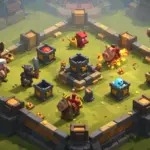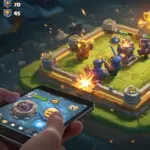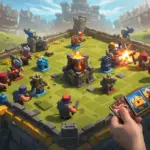Clash Royale Deck Archetypes: Control, Beatdown, Siege Explained
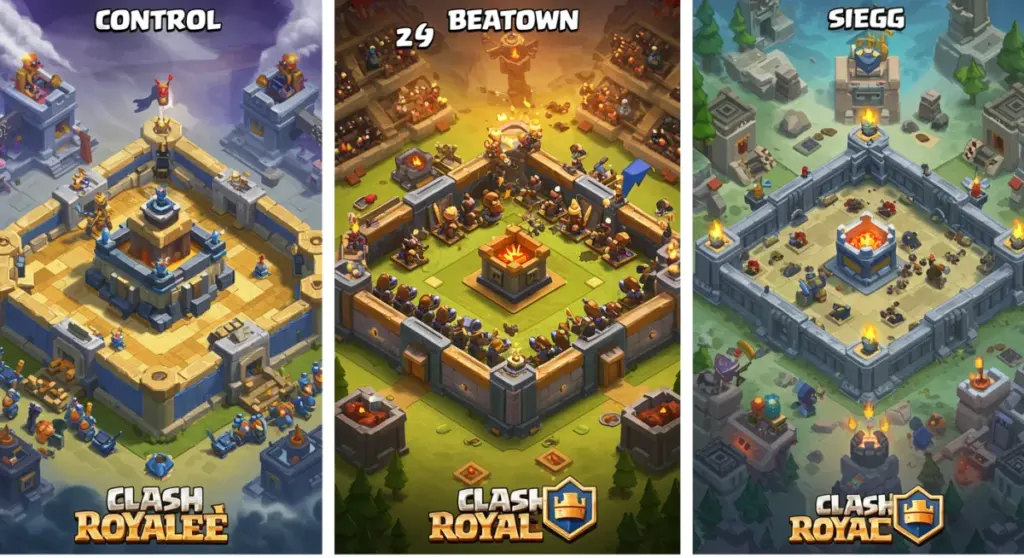
Anúncios
Understanding Clash Royale deck archetypes like Control, Beatdown, and Siege is crucial for strategic gameplay, allowing players to identify strengths, counter weaknesses, and ultimately climb the ranks effectively in the arena.
To truly master the arena in Supercell’s dynamic mobile game, Clash Royale Deck Archetypes: Understanding the Strengths and Weaknesses of Control, Beatdown, and Siege is not just helpful, it’s essential. This guide delves deep into the core philosophies behind these dominant playstyles, empowering you to not only build better decks but also to anticipate and counter your opponents with unparalleled precision.
The foundational principles of Clash Royale deck archetypes
Clash Royale, at its core, is a game of strategic card deployment and resource management. Success hinges on a deep understanding of your deck’s inherent strengths and weaknesses, as well as those of your opponent. The concept of deck archetypes provides a framework for categorizing and understanding common strategies, helping players to quickly identify the general game plan of an opponent and adjust their own tactics accordingly. This foundational knowledge is what separates casual players from seasoned veterans who consistently achieve high ranks.
These archetypes are not rigid rules but rather flexible guidelines that describe a deck’s primary win condition and how it aims to achieve victory. By grasping these principles, you gain a significant advantage, allowing for more informed card choices, better elixir management, and more effective defensive and offensive pushes. It’s about recognizing patterns and leveraging them to your benefit in every single match.
Why archetypes matter for every player
Understanding deck archetypes is not just for professional players; it’s a critical skill for anyone looking to improve their Clash Royale game. It enables you to:
- Predict opponent’s moves: Knowing an archetype suggests likely cards and strategies.
- Optimize your own deck building: Construct decks with clear win conditions and synergy.
- Improve in-game decision-making: Make better choices on when to attack, defend, or save elixir.
- Counter effectively: Identify weaknesses in opposing archetypes and exploit them.
Ultimately, a strong grasp of these archetypes leads to a more enjoyable and successful gaming experience. It transforms random card plays into calculated strategic maneuvers, giving you a sense of control over the unpredictable nature of the arena. This strategic depth is what makes Clash Royale so captivating and rewarding for those who invest the time to understand its nuances.
Control decks: mastering the tempo and defense
Control decks are arguably the most cerebral of the Clash Royale archetypes, focusing on out-cycling and out-defending the opponent while slowly chipping away at their towers. The primary goal is to maintain elixir advantage, neutralize enemy threats efficiently, and then punish overcommitments. This playstyle requires patience, precise card placement, and an exceptional understanding of elixir trade-offs.
Players utilizing control decks aim to dictate the pace of the game, preventing the opponent from executing their win condition effectively. They often feature strong defensive units, spells for area control, and a modest win condition that can be deployed once a significant elixir lead has been established or the opponent has exhausted their resources. It’s a war of attrition, where every elixir spent and every card played is a calculated move towards a slow, inevitable victory.
Strengths of control decks
Control decks shine in their ability to shut down aggressive pushes and maintain a steady defense. Their strengths include:
- Elixir efficiency: Excellent at generating positive elixir trades.
- Defense: Robust defensive capabilities against various threats.
- Versatility: Can adapt to different opponent strategies by reacting.
- Late-game power: Often become stronger as the game progresses and elixir cycles become faster.
A well-played control deck can feel impenetrable, frustrating opponents who struggle to break through its defenses. This archetype excels against slower, heavy decks that rely on big pushes, as control decks can dismantle these pushes piece by piece, turning elixir deficits into advantages.
Weaknesses of control decks
Despite their defensive prowess, control decks are not without their vulnerabilities. They can struggle against:
- Aggressive cycle decks: Fast-paced decks can overwhelm control players before they establish their defense.
- Rocket/Spell cycle decks: Direct damage spells can bypass defenses and chip down towers faster than anticipated.
- Player errors: A single misplay or poor elixir trade can be severely punishing.
Control decks demand a high level of skill and focus. They require players to constantly be aware of their elixir count, their opponent’s hand, and the optimal timing for every card. Any lapse in judgment can quickly turn a defensive advantage into a critical vulnerability, making them less forgiving for beginners. The constant pressure of maintaining control can be mentally taxing, but the rewards for mastering this archetype are substantial.
Beatdown decks: overwhelming force and relentless pushes
Beatdown decks are the antithesis of control, focusing on building massive pushes behind a high-hitpoint tank. The objective is to create an unstoppable force that marches directly to the opponent’s tower, dealing overwhelming damage. These decks typically feature expensive, high-impact cards that, when combined, can quickly demolish defenses and secure victory.
The strategy revolves around committing large amounts of elixir to a single lane, often starting with a tank at the back of the arena to give it time to build support troops. Once the tank reaches the bridge, a formidable offensive force is unleashed, making it incredibly difficult for the opponent to defend without suffering significant tower damage. It’s a high-risk, high-reward playstyle that emphasizes aggression and brute force.
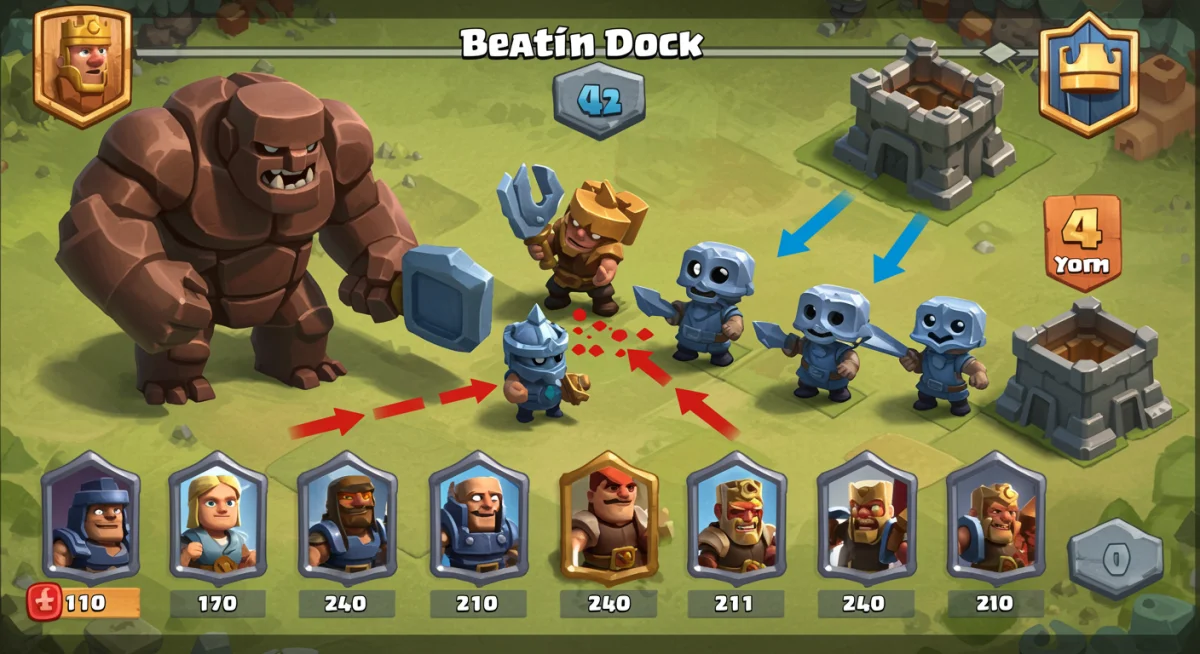
Key components of a beatdown deck
A typical beatdown deck will include:
- A primary tank: Golem, Lava Hound, Giant, or Royal Giant are common choices.
- Support troops: Wizards, Musketeers, Minions, or Electro Wizards protect the tank and deal damage.
- Spells: Arrows, Zap, or Fireball clear swarms and provide additional offensive power.
- Elixir generation (optional but common): Elixir Collector helps fund expensive pushes.
The synergy between these cards is paramount. The tank absorbs damage, allowing the support troops to deliver their devastating blows. Elixir management is crucial, as beatdown players must know when to commit to a push and when to conserve elixir for defense, often relying on double elixir time to unleash their full potential.
Strengths of beatdown decks
Beatdown decks excel at breaking through defenses and securing decisive victories. Their main strengths include:
- Powerful pushes: Can create unstoppable offenses that overwhelm opponents.
- Tower destruction: Capable of taking down towers very quickly once a push connects.
- Psychological pressure: The sheer size of a beatdown push can intimidate opponents into misplays.
When a beatdown push gets going, it can feel like playing against an avalanche. Opponents are forced to react decisively, often depleting their elixir reserves just to survive the initial assault. This pressure often leads to mistakes, which beatdown players are quick to capitalize on, turning a defensive struggle into a swift victory.
Weaknesses of beatdown decks
While powerful, beatdown decks have notable vulnerabilities:
- Vulnerability to fast cycle: Can be punished by quick counter-pushes in the opposite lane.
- High elixir cost: Committing to a beatdown push leaves the player vulnerable to swift counter-attacks.
- Building targeting: Buildings can pull tanks away from the desired target, disrupting the push.
- Inferno Tower/Dragon: High damage-per-second units can melt tanks quickly.
Beatdown decks are susceptible to punishment if the initial push fails or is expertly defended. A poorly timed Golem or Lava Hound can leave the player with little elixir to defend against a swift counter-attack, often leading to a lost tower. They also struggle against decks that can consistently pull their tanks or deal massive damage to them, making strategic deployment critical.
Siege decks: long-range harassment and strategic placement
Siege decks operate on a fundamentally different principle than control or beatdown. Their primary win condition involves deploying long-range offensive buildings, such as the X-Bow or Mortar, within their own territory to target the opponent’s towers from a distance. This playstyle focuses on protecting these siege units while they slowly chip away at the enemy’s defenses.
Success with a siege deck relies heavily on precise placement, strong defensive support, and an understanding of cycle mechanics. Players aim to establish a siege unit, defend it vigorously, and then cycle back to another siege unit or supporting cards to maintain pressure. It’s a game of calculated risk, where the siege unit acts as both an offensive threat and a magnet for enemy attention, allowing for positive elixir trades on defense.
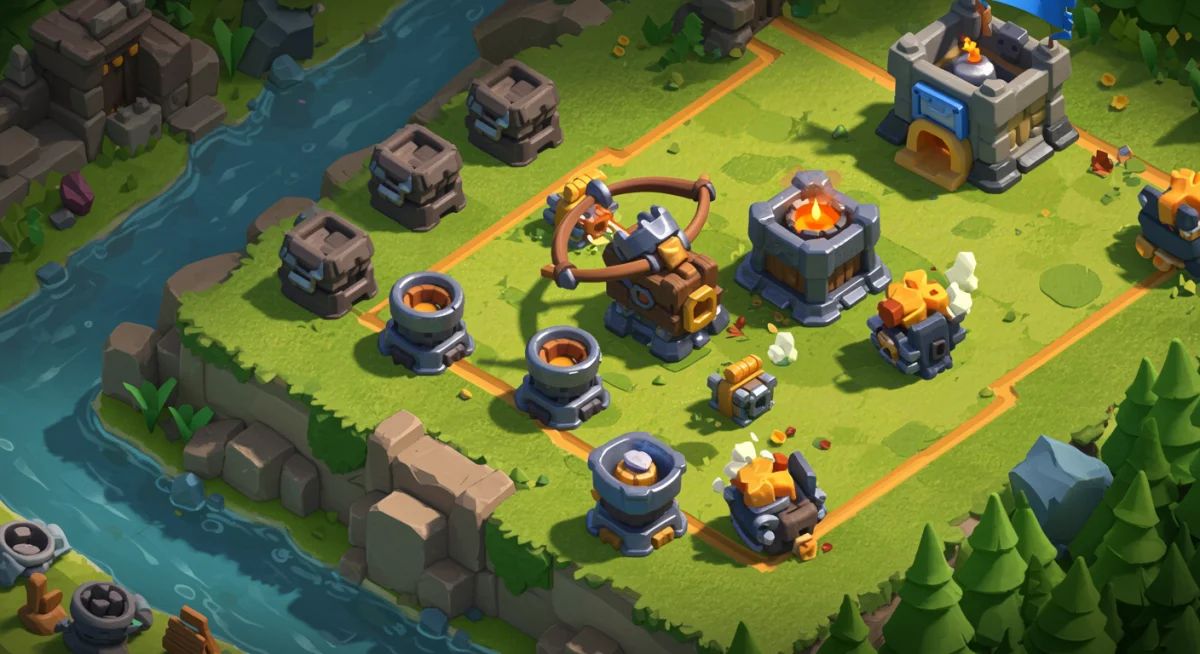
The core strategy of siege decks
The essence of a siege deck is to:
- Deploy siege unit: Place X-Bow or Mortar within range of an enemy tower.
- Defend the unit: Use troops and spells to protect the siege building from destruction.
- Cycle back: Quickly cycle through cards to deploy another siege unit or reinforce defenses.
- Chip damage: Allow the siege unit to slowly destroy the enemy tower.
This strategy demands constant vigilance and quick reactions. Players must anticipate enemy counter-pushes and have the right defensive cards in hand to protect their investment. Elixir management is crucial, as overcommitting to defense can leave the player vulnerable to attacks on the opposite lane, while under-defending can result in the loss of the siege unit and a significant elixir disadvantage.
Strengths of siege decks
Siege decks are incredibly effective when played correctly, offering several distinct advantages:
- Safe damage: Can deal damage to towers without crossing the river, minimizing retaliatory damage.
- Defensive value: Siege units themselves can act as defensive distractions or damage dealers against ground troops.
- Punishment for overcommitment: Can punish opponents who overcommit on offense by quickly placing a siege unit.
The ability to deal damage from a safe distance provides a psychological edge, forcing opponents to engage on the siege player’s terms. When an X-Bow locks onto a tower, the pressure is immense, often leading to desperate and inefficient defensive plays from the opponent, which the siege player can then exploit for elixir advantage.
Weaknesses of siege decks
Despite their unique offensive capabilities, siege decks have specific weaknesses:
- Vulnerability to tanky units: High-hitpoint tanks can absorb many shots, allowing them to reach and destroy the siege unit.
- Building targeting units: Hog Rider, Battle Ram, or Royal Giant can bypass defenses and target the siege unit directly.
- Spells: Heavy spells like Rocket or Lightning can destroy siege units for an even elixir trade, denying their value.
- Lack of direct counter-push: If the siege unit is destroyed, the deck often lacks a strong retaliatory push.
Siege decks are often seen as one-trick ponies, and if that trick is countered, they can struggle to find an alternative win condition. Players must be adept at protecting their siege units and knowing when to concede an X-Bow or Mortar to save elixir for a better defensive setup. The reliance on a single primary win condition makes them vulnerable to specific counter-cards and aggressive offensive plays.
Hybrid archetypes and evolving meta
While Control, Beatdown, and Siege are the foundational Clash Royale Deck Archetypes, the game’s meta is constantly evolving, leading to the emergence of hybrid archetypes. These decks blend elements from multiple core strategies, creating nuanced playstyles that are harder to categorize but often highly effective. Understanding these hybrids requires a deeper analytical approach, as their win conditions might shift depending on the matchup or the flow of the game.
For instance, a ‘Cycle Beatdown’ deck might incorporate a tank like the Giant but use cheaper support cards to cycle faster, allowing for more frequent, albeit smaller, pushes. Similarly, a ‘Control Siege’ deck might use defensive elements to protect an X-Bow more robustly while maintaining elixir advantage. These hybrids demonstrate the flexibility and depth of Clash Royale’s deck-building possibilities.
Popular hybrid archetypes
Some common hybrid archetypes include:
- Spell Cycle: Focuses on dealing direct tower damage with spells (Rocket, Fireball) while defending effectively. Often seen as a control variant.
- Bridge Spam: Aggressive decks that deploy fast, high-damage units at the bridge to overwhelm opponents quickly, blending elements of beatdown and cycle.
- Split Lane Pressure: Decks that attack both lanes simultaneously to divide the opponent’s attention and elixir, often using a mix of medium-cost threats.
The beauty of hybrid archetypes lies in their unpredictability and adaptability. They challenge players to think outside the traditional archetype boxes, forcing them to identify the primary win condition and defensive strategies on the fly. Mastering these decks requires not only mechanical skill but also a profound understanding of card interactions and matchup dynamics.
Adapting your gameplay based on archetype recognition
Recognizing your opponent’s deck archetype early in a match is a game-changer. It allows you to anticipate their strategy, adjust your elixir management, and deploy your cards in the most effective manner. This adaptive gameplay is a hallmark of high-level Clash Royale players and is crucial for consistently climbing the ladder. The first 30-60 seconds of a match are vital for gathering information and formulating a game plan.
For example, if you identify a beatdown deck, you know to save your heavy defensive cards and prepare for a large push. Against a siege deck, you’ll want to focus on pressuring their siege unit or punishing them in the opposite lane. Against a control deck, patience and elixir advantage become your top priorities. This proactive approach significantly increases your chances of victory.
Strategies for countering different archetypes
- Against Beatdown: Focus on strong single-target damage (Inferno Tower/Dragon), reset mechanics (Electro Wizard), and buildings to pull tanks. Punish their elixir commitments with quick counter-pushes in the opposite lane.
- Against Control: Maintain elixir neutrality or advantage. Force them to overcommit on defense. Utilize spells for chip damage if direct pushes are difficult. Be patient and wait for openings.
- Against Siege: Pressure the siege unit directly with tanky troops or spells. Attack the opposite lane to force their defensive cards away from the siege unit. Use buildings to distract their support troops.
Understanding these general counter-strategies empowers you to make informed decisions under pressure. It’s not about having a perfect counter to every card, but rather knowing the general weaknesses of an archetype and how to exploit them with the cards available in your own deck. This strategic flexibility is what separates good players from great ones.
Building and refining your own deck
Armed with a comprehensive understanding of Clash Royale Deck Archetypes, you are now better equipped to build and refine your own decks. The process of deck building is both an art and a science, requiring a balance of offensive power, defensive capabilities, and synergistic card interactions. Start by identifying a win condition that aligns with your preferred playstyle—do you enjoy overwhelming opponents, meticulously defending, or chipping away from a distance?
Once you have a core win condition, select supporting cards that enhance its strengths and mitigate its weaknesses. Consider your average elixir cost, ensuring it’s manageable for your playstyle. Test your deck extensively, analyze your replays, and be prepared to make adjustments based on your performance against various archetypes. The meta is always shifting, so a static deck will eventually fall behind.
Key considerations for deck building
- Win condition: What is the primary way your deck aims to win? (e.g., Golem push, X-Bow lock, Hog Rider chip).
- Defense: How will you stop common enemy win conditions? (e.g., tank killers, splash damage, air defense).
- Cycle: How quickly can you get back to your key cards? (low-cost cards, elixir collector).
- Synergy: Do your cards work well together? (e.g., tank and spank, spell bait).
- Average elixir cost: Is your deck too expensive to defend or too cheap to make impactful pushes?
Refining your deck is an ongoing process. Pay attention to the cards that consistently get you positive elixir trades and those that feel clunky or ineffective. Don’t be afraid to experiment with different cards or even entirely new archetypes. The best players are those who are constantly learning, adapting, and innovating their strategies to stay ahead of the curve. This continuous refinement is what ensures your deck remains competitive and effective in the ever-changing landscape of Clash Royale.
| Archetype | Core Strategy |
|---|---|
| Control | Out-defend, gain elixir advantage, chip towers slowly. |
| Beatdown | Build large pushes behind a tank to overwhelm towers. |
| Siege | Deploy long-range buildings to chip towers from your side. |
| Hybrid | Combines elements of multiple archetypes for adaptability. |
Frequently asked questions about Clash Royale deck archetypes
There isn’t a single “best” archetype; effectiveness depends on the current meta, player skill, and personal preference. Each archetype has strengths and weaknesses that make it favorable or unfavorable in different matchups. Mastering an archetype that fits your playstyle is more important than chasing a perceived “best” one.
Pay attention to their first few card plays. A Golem at the back usually signals Beatdown, an X-Bow near the bridge suggests Siege, and cheap cycle cards with defensive units often indicate a Control deck. Recognizing key win conditions or expensive cards early helps.
Yes, absolutely! These are known as hybrid archetypes. Many successful decks blend strategies, like a Beatdown deck with strong defensive control elements or a Siege deck that uses some cycle cards for faster rotation. Experimentation is key to finding effective combinations.
Elixir is the primary resource in Clash Royale, and managing it effectively dictates your ability to deploy cards for offense and defense. Positive elixir trades lead to an advantage, allowing you to overwhelm opponents. Poor elixir management can leave you vulnerable and unable to respond to threats.
The Clash Royale meta is dynamic, influenced by balance changes, new card releases, and community innovation. Major meta shifts can occur with significant updates (every few months), but subtle variations within archetypes are common weekly or monthly as players discover new optimal card combinations and counters.
Conclusion
Mastering Clash Royale Deck Archetypes: Understanding the Strengths and Weaknesses of Control, Beatdown, and Siege is a cornerstone of advanced gameplay. By recognizing these fundamental strategies, players gain a profound advantage, enabling them to make more informed decisions, build more effective decks, and adapt their playstyle to counter opponents. Whether you prefer the patient precision of Control, the overwhelming force of Beatdown, or the strategic harassment of Siege, a deep understanding of these archetypes will undoubtedly elevate your game and help you achieve consistent success in the arena.


